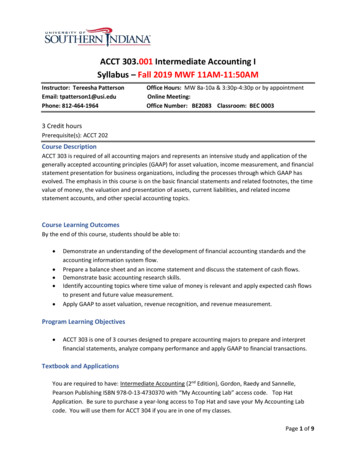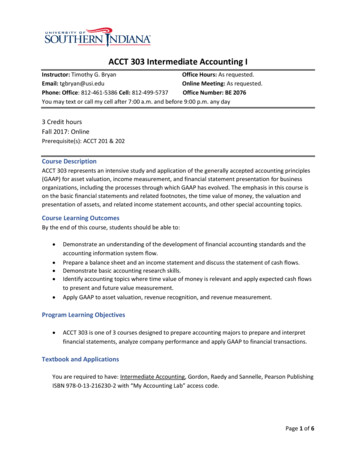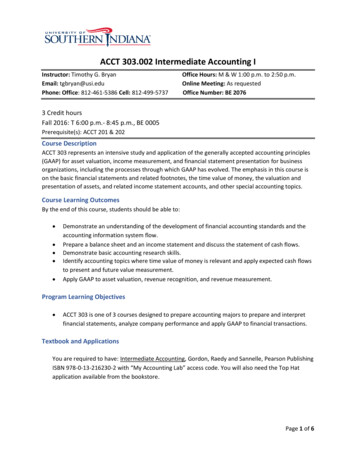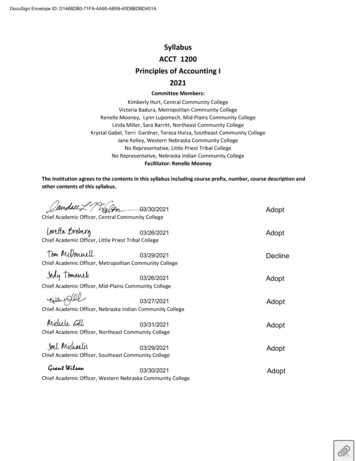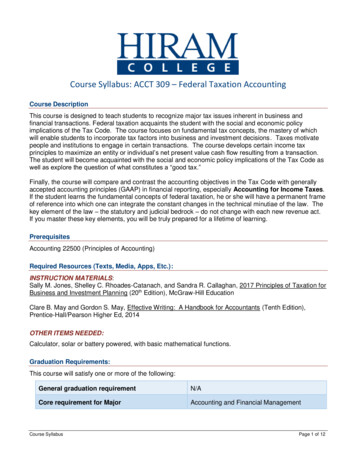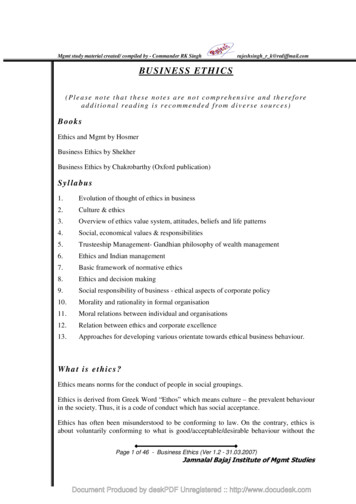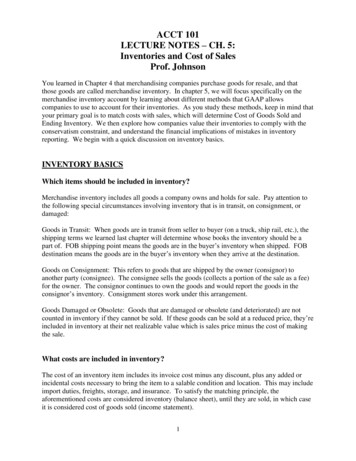
Transcription
ACCT 101LECTURE NOTES – CH. 5:Inventories and Cost of SalesProf. JohnsonYou learned in Chapter 4 that merchandising companies purchase goods for resale, and thatthose goods are called merchandise inventory. In chapter 5, we will focus specifically on themerchandise inventory account by learning about different methods that GAAP allowscompanies to use to account for their inventories. As you study these methods, keep in mind thatyour primary goal is to match costs with sales, which will determine Cost of Goods Sold andEnding Inventory. We then explore how companies value their inventories to comply with theconservatism constraint, and understand the financial implications of mistakes in inventoryreporting. We begin with a quick discussion on inventory basics.INVENTORY BASICSWhich items should be included in inventory?Merchandise inventory includes all goods a company owns and holds for sale. Pay attention tothe following special circumstances involving inventory that is in transit, on consignment, ordamaged:Goods in Transit: When goods are in transit from seller to buyer (on a truck, ship rail, etc.), theshipping terms we learned last chapter will determine whose books the inventory should be apart of. FOB shipping point means the goods are in the buyer’s inventory when shipped. FOBdestination means the goods are in the buyer’s inventory when they arrive at the destination.Goods on Consignment: This refers to goods that are shipped by the owner (consignor) toanother party (consignee). The consignee sells the goods (collects a portion of the sale as a fee)for the owner. The consignor continues to own the goods and would report the goods in theconsignor’s inventory. Consignment stores work under this arrangement.Goods Damaged or Obsolete: Goods that are damaged or obsolete (and deteriorated) are notcounted in inventory if they cannot be sold. If these goods can be sold at a reduced price, they’reincluded in inventory at their net realizable value which is sales price minus the cost of makingthe sale.What costs are included in inventory?The cost of an inventory item includes its invoice cost minus any discount, plus any added orincidental costs necessary to bring the item to a salable condition and location. This may includeimport duties, freights, storage, and insurance. To satisfy the matching principle, theaforementioned costs are considered inventory (balance sheet), until they are sold, in which caseit is considered cost of goods sold (income statement).1
Here is a guided example on determining inventory costs:http://www.viddler.com/embed/120707d7/?f 1&autoplay 0&player full&disablebranding 0%22%20width %22694%22%20height %22520%22%20frameborder %220%22%3E%3C/iframe%3EWhat is the importance of a physical count, and what steps are taken to ensure thereliability of that count?The perpetual inventory system allows managers to gauge inventory levels and determine COGSwithout actually having to physically count inventory (called “taking an inventory”), but eventssuch as theft, loss, damage and errors can cause actual inventory on hand to differ fromcalculated levels. Thus, nearly all companies take an inventory at least once a year; the physicalcount is used to adjust the inventory account balance to the actual inventory on hand.Internal controls refer to policies and procedures managers use to protect company assets,promote efficient operations, uphold company policies, and ensure reliable accounting. Wetouch more on this in chapter 6, but with regards to inventory, the following internal controlprocedures are followed:a.b.c.d.e.Prenumbered inventory tickets; each ticket must be accounted for.Those responsible for inventory do not count inventory, separation of duties.Counters confirm the validity of inventory, including its existence, amount, and quality.A second count is taken by a different counter.A manager confirms that all inventories are ticketed once and only once, which avoidsdouble counting an item in stock.INVENTORY COSTING UNDER A PERPETUAL SYSTEMThe major goal of inventory costing is to properly match costs with sales. The matchingprinciple is used to decide how much of the cost of goods available for sale is debited to expense(COGS on the income statement) and how much is carried forward as an asset (MerchandiseInventory on the balance sheet). Four methods are commonly used to assign costs to COGS andinventory, and each method assumes a specific pattern for how costs flow through inventory.Physical flow and cost flow do not need to be the same.a. First-in, first-out (FIFO) – assumes costs flow in the order incurred. Assumes the oldestunits are sold first; the newest units are still in stock.b. Last-in, last-out (LIFO) - assumes costs flow in the reverse order occurred. Assumes thenewest units are sold first; the oldest units are still in stock.2
c. Weighted average—assumes costs flow in an average of the costs available. As salesoccur, weighted average computes the average cost per unit of inventory at time of saleand charges this cost per unit sold to cost of goods sold leaving average cost per unit onhand in inventoryd. Specific identification—each item can be identified with a specific purchase and invoice.As sales occur, cost of goods sold is debited for the actual or invoice cost, leaving actualcosts of inventory on hand in the inventory account.Here is a guided example that demonstrates each of these four costing methods using the samedata set in each case:http://www.viddler.com/embed/c43c85b4/?f 1&autoplay 0&player full&disablebranding 0%22%20width %22694%22%20height %22520%22%20frameborder %220%22%3E%3C/iframe%3EWhat are the financial statement effects of the four costing methods?When purchase prices do not change, each inventory costing method assigns the same amountsto inventory and to COGS. However, when purchase prices change by either rising or declining,the methods assign different cost and ending inventory amounts.a. Rising price environment:CPricesFIFO: assigns the lowest amount to COGS resultingin the highest gross profit and highest net income.Advantage: inventory on the balance sheetapproximates its current replacement cost; it alsomimics the flow of goods for most businesses.BASold asCOGSRemainsin EndingInventoryTimeLIFO assigns the highest amount to COGS resulting inlowest gross profit and lowest net income. Advantage:better match of current costs with revenues in computinggross margin.PricesCBSold asCOGSATimeRemainsin EndingInventory3
b. Declining price environment:APricesFIFO: assigns the lowest amount to COGS resultingin the highest gross profit and highest net income.Advantage: inventory on the balance sheetapproximates its current replacement cost; it alsomimics the flow of goods for most businesses.Sold asCOGSRemainsin EndingInventoryBCTimeASold asCOGSPricesLIFO assigns the highest amount to COGS resulting inlowest gross profit and lowest net income. Advantage:better match of current costs with revenues in computinggross margin.BRemainsin EndingInventoryCTimec. Weighted average: in both rising and declining price environments, yields resultsbetween FIFO and LIFO which smooths out price changes.d. Specific identification: in both rising and declining price environments, yields resultsthat depend on which units are sold, which exactly matches costs and revenues.4
e. The following chart summarizes the effects on the financial statements of using FIFOand LIFO in both rising and declining price environments.When purchase costs are:RisingFIFO ReasonRisingReasonLIFOIncome StatementCOGSIncome before taxesIncome tax provisionBalance SheetMerchandise inventoryStatement of Retained EarningsRetained EarningsWhen purchase costs are:higher last units sold are more expensive lower first units sold are cheaperhigher lower COGS means higher incomelower higher COGS, lower incomelower lower income, lower tax liability higher higher income means higher tax liabilitylower expensive units have been soldhigher more expensive units remainlower lower income, lower earningshigher higher income, higher earningsDecliningReasonLIFODecliningFIFO ReasonIncome StatementCOGSIncome before taxesIncome tax provisionBalance SheetMerchandise inventoryStatement of Retained EarningsRetained Earningshigher more expensive (older) units sold firstlower last units sold are cheaperlower higher COGS, lower incomehigher lower COGS, higher incomehigher higher income, higher tax liability lower lower income implies lower tax liabilityhigher more expensive items remainlower cheaper (newer) items remainhigher higher income, higher earningslower lower income, lower earningsWhat are the tax effects of Costing Methods?Since inventory costs affect net income, costing methods for inventory have potential taxeffects. Keep in mind that we are studying financial accounting, and that its aim is to generateuseful information about the company through financial statements. The main aim of taxaccounting is to help companies generate taxable income to determine tax expense. Withthese two goals in mind, companies often use different costing methods for financial reportingvs tax reporting. For example, it may use FIFO for financial reporting because it betterrepresents business performance, and use LIFO for tax reporting because it creates lower taxexpense.The only exception is when LIFO is used for tax reporting; in this case the IRS also requiresLIFO to be used for financial reporting.Why is Consistency in costing methods important?5
Consistency enables comparability. The consistency concept requires use of same accountingmethods period after period so the financial statements are comparable across periods.Changing methods is acceptable if it will improve financial reporting. The full-disclosureprinciple requires that statement notes report the type of change, its justification, and its effecton income. Different methods may be consistently applied to different categories ofinventory.VALUING INVENTORY AT LCM AND THE EFFECTS OFINVENTORY ERRORSWhat is the Lower of Cost or Market (LCM)?Accounting principles require that inventory be reported on the balance sheet at the lower ofcost or market (LCM). Market is the current replacement cost of purchasing the sameinventory items in the usual manner. When the recorded cost of inventory is higher than thereplacement cost, a loss is recognized on the income statement. When the recorded cost islower, no adjustment is made. Lower of cost or market pricing is applied to either: 1) eachindividual item separately, 2) major categories of items, or 3) to the entire inventory.Accounting rules require that inventory be adjusted to market when market is less than cost,but inventory cannot be written up to market when market exceeds cost. The conservatismconstraint prescribes the use of the less optimistic amount when more than one estimate of theamount to be received or paid exists and these estimates are about equally likely.Here is a guided example on Lower of Cost or Market:http://www.viddler.com/embed/d1d3d907/?f 1&autoplay 0&player full&disablebranding 0%22%20width %22694%22%20height %22520%22%20frameborder %220%22%3E%3C/iframe%3EFinancial Statement Effects of Inventory ErrorsThe following formula will help you understand the financial statement implications ofinventory errors:Cost of Goods Sold Beginning Inventory Purchases – Ending InventoryBased on above, we see how an inventory error (where either beginning or ending inventory isover or under-stated), can affect both the income statement and balance sheet by distortingCOGS, which affects gross profit, net income, current assets, and equity. It also causesmisstatements in the next period’s financial statements because ending inventory of oneperiod is the beginning inventory of the next.Income Statement effects:6
a.b.c.d.If ending inventory is understated, COGS is overstated, net income is understated.If beginning inventory is understated, COGS is understated, net income is overstated.If ending inventory is overstated, COGS is understated, net income is overstated.If beginning inventory is overstated, COGS is overstated, net income is understated.Balance Sheet effects:a. If ending inventory is understated, assets and equity are understated.b. If ending inventory is overstated, assets and equity are overstated.c. Errors in beginning inventory do not yield misstatements on the end-of-period balancesheet, but they do affect the current period’s income statement (see above).GROSS PROFIT METHOD OF ESTIMATING ENDING INVENTORY(FROM CH. 5 APPENDIX)The gross profit method estimates the cost of ending inventory when circumstances prohibit aphysical count. For example, a company may want to know ending inventory for insuranceclaims when inventory is destroyed, lost or stolen. Steps below:a. Determine the normal gross profit percentage from recent periods.b. Find the COGS percentage (100% less gross profit percentage).c. Multiply actual sales by the cost of goods sold percentage to get estimated cost ofgoods sold.d. Subtract estimated cost of goods sold from the actual amount of cost of goodsavailable for sale (beginning inventory purchases) to get estimated ending inventoryat cost.Here is a guided example showing the gross profit method:http://www.viddler.com/embed/9d20a6f5/?f 1&autoplay 0&player full&disablebranding 0%22%20width %22694%22%20height %22520%22%20frameborder %220%22%3E%3C/iframe%3ERATIO ANALYSISInventory turnover: used to measure how quickly a company sells its inventory and canaffect a merchandiser’s ability to pay its short-term obligations. Formula below, the answerreflects the number of times a company’s average inventory was sold during an accountingperiod.Cost of Goods Sold7
------------------------Average InventoryDays Sales in Inventory: used to measure how much inventory is available in terms of thenumber of days’ sales. Inventory management is a major emphasis for most merchandisers;they must both plan and control in
LECTURE NOTES – CH. 5: Inventories and Cost of Sales Prof. Johnson You learned in Chapter 4 that merchandising companies purchase goods for resale, and that those goods are called merchandise inventory. In chapter 5, we will focus specifically on the merchandise inventory account by learning about different methods that GAAP allows


